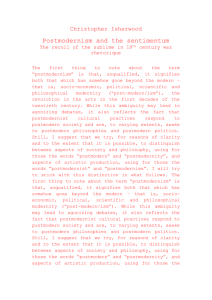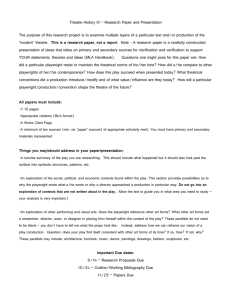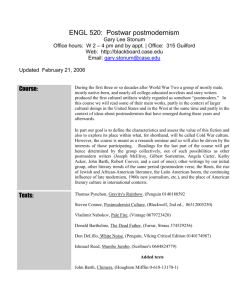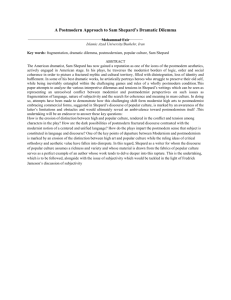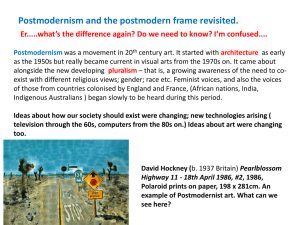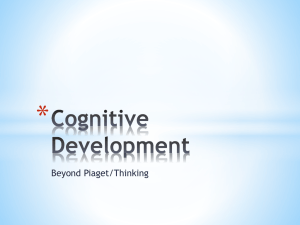postmodern drama
advertisement
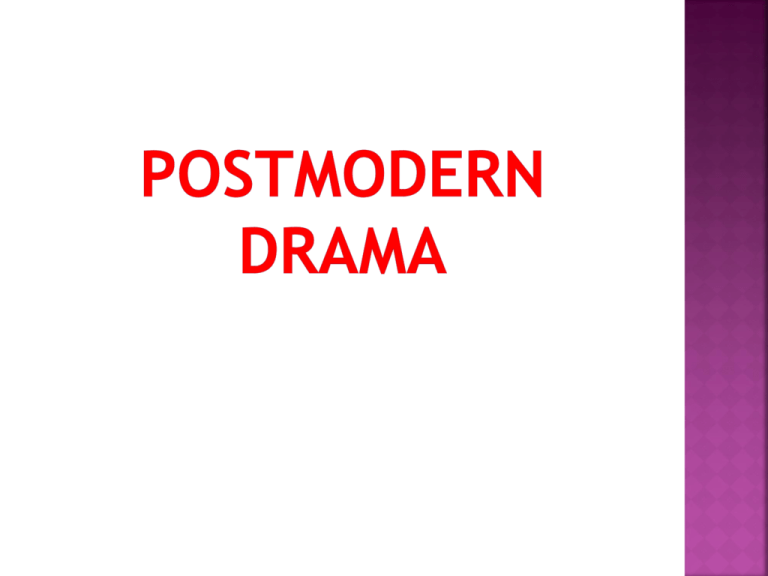
Have you ever experienced information overload? Do you ever feel overwhelmed or anxious because there are so many choices out there – what to wear what music to enjoy what toothpaste to use? Do you mistrust anyone who tells you that there is only one way of looking at the world? Postmodernism simply means ‘after Modernism’. It is a rejection of all the certainties of the Modernist era. ‘Speak Postmodernism’ academic jargon terms concepts What makes Postmodern Theatre recognisably Postmodern. Postmodernism is both: Cultural movement with a certain set of aesthetics Philosophical and socio-historical movement Postmodernism is a term or set of ideas to describe a set of features or characteristics Film Architecture Literature Theatre Sociology Cultural studies Communications Fashion Socioeconomictechnologi cal Technology Art Music Major world events like the Holocaust and Hiroshima, forced thinkers, artists, philosophers and ordinary people to ask questions about reality, authority and humanity’s role in the world. Is Postmodernism deconstructs (takes apart) those ‘truths’ and tries to make sense of the many uncertainties, ironies, contradictions, and multiple points of view that exist in the world. The bigger picture Modernism in the 20th century was characterised by many ideologies and –isms, all of which claimed to have ‘the answer’, a system to live by, a grand truth. Is there such a thing as absolute truth that should determine the way we see the world and how we should behave? How Modernism became Postmodernism Modernism has its roots in the 19th century – it came about as people rejected the old Victorian standards of how art should be made and consumed, and what it should mean. Rebelling against the ideal of portraying reality accurately and objectively, artists and writers focused more on impressionism and subjectivity. There was an emphasis on how seeing (or reading or perception itself) takes place, rather than on what is perceived. There was a new tendency toward reflexivity*, or self-consciousness, in the production of a work of art. For example, in Epic Theatre, the playwright would interrupt the action of the play, calling attention to the fact that it is a constructed piece of theatre, breaking the illusion of the ‘fourth wall’. In Postmodernism, this is taken further, until the very idea of the author’s authority is laughed at, and the emphasis shifts to the audience’s ability to make meaning for themselves. Many of the theatrical and artistic movements of the 20th century, such as Epic Theatre and Theatre of the Absurd, played with fragmented forms, broken narratives and random collages. WHAT IS THE DIFFERENCE BETWEEN EPIC THEATRE , THEATRE OF THE ABSURD AND POST MODERN DRAMA? Epic Theatre and Theatre of the Absurd a core narrative and logical unfolding of events still existed. Postmodernist Drama, those narrative structures are taken apart (deconstructed) and put back together in ways that are sometimes disruptive and fragmented. Performances are constructed from pastiche*, collage and fragmented storylines In terms of style, Modernism saw a stripping away of the trappings of Realism to more minimalist designs. Postmodernism borrows from realism, baroque, classicism, minimalism. In the 20th century, there was a blurring of boundaries between different disciplines, and also between ‘high’ and ‘low’ culture. In Postmodernism, the divisions between genres and disciplines disappear altogether. Elitism is laughed at, and filmmakers such as Quentin Tarantino celebrate ‘pulp’ movies, and recycle popular culture in their work. The most important difference is in attitude. In Modernism, the artist, writer or director was seen as the ultimate meaning-maker. While Modernist artworks lament the loss of meaning and coherence, and see the fragmentation of history as tragic Postmodernism celebrates this, embracing chaos, nonsense and absurdity, and creating a sense of fun, playfulness and irony, shopping in the ‘supermarket of style’ and allowing multiple meanings to co-exist at the same time. Rejecting master narratives Grand narrative or Master narrative Dominant set of beliefs that a society or nation holds as the absolute truth. Consider each of the following statements and discuss ways in which their absolute truth can be picked apart, disproved or seen to be untrue. Who would benefit from keeping such a belief in place? ‘Capitalism is democratic.’ ‘America has a moral duty to police the world.’ Modernist plays crafted around a central premise Postmodernist texts multiple realities Do not offer a neat solution or a closed ending. T Postmodern play explode the idea of authority or of a single dominant ideology. For example, Sam Shepard’s plays deconstruct the myth of the American Dream – a dominant master narrative of American culture. Pastiche The word comes from French, and is used to describe a visual art technique similar to collage Different texts, images and media forms are pasted together to create one piece Borrowing, referencing, and layering different texts and images together is a typical feature of Postmodern Drama Dramatic Elements Existing ways of seeing the world are subverted and questioned Often by taking things apart and putting the pieces back together in new ways This process is called ‘deconstruction’ Playwrights also take apart usual expectations about character and human experience. For example, rather than portraying a well-rounded, coherent character, a postmodern playwright might take fragments of a character’s mind Directors might get actors to play each aspect of the protagonist’s consciousness Take a well-known classical text and deconstruct that Hamletmachine, German playwright, Heiner Müller, takes apart Shakespeare’s Hamlet and puts the pieces back together in a different way, spliced with images or texts from pop culture. Even the way in which the audience watches a play is deconstructed, as the text pokes fun at the audience, and at our usual expectations of what is ‘normal’ in a theatre performance. The play opens with the line, ‘i was hamlet. I stood at the shore and talked with the surf BLABLA, the ruins of europe behind me.’ Hamletmachine is a typical postmodern experiment in deconstructing text. It trashes high art in favour of pop and presents the audience with the image of a fragmenting capitalist madhouse, with hamlet barking ‘heil Coca Cola!’.] Broken narratives, story webs and multiple realities Narrative structures tend not to be linear, clear or complete. Plays have broken narratives collections of overlapping stories conflicting voices multiple points of view Reality, in a Postmodern world, is not a clear, neat story, so why should a play try to pretend that life is simple? Modernist play, the structure will typically have a clear beginning, middle and end Postmodernist play, multiple realities overlap Different characters from different parts of history, art and literature meet together around one table. They speak about common themes: husbands, marriage, babies, and their narratives collide, meet up and separate. Opening scene of Caryl Churchill’s Top Girls Top Girls deals with women’s losing their humanity in order to attain power in a maledominated environment[ Popular culture Postmodern theatre moves away from idea of ‘high art’ just for the elite. Directors such as Quentin Tarantino, e.g. in Pulp Fiction, draw on a variety of ‘pulp’ genres, mixing and referencing these. In Baz Luhrman’s Romeo + Juliet an ‘elite’ genre (Shakespeare) is saturated in popular culture – music, fashion, and images from a consumer-driven world. Death of the AUTHOR The reader is the creator of meaning The author does not hold any ultimate truth the product created Scripts often just a starting point Performance itself layered with images, soundscapes and multimedia experiences that could not have been captured in a script The text for Hamletmachine, for example, is more like a score for an orchestra than a script for actors to follow faithfully. The director might interpret, add images or choose styles to flesh out the script. In Ben Elton’s Popcorn, a debate rages as to whether or not movies are responsible for violence in society. The playwright does not offer one point of view, rather leaving the audience to construct their own ‘ultimate’ message. This concept, known in literature as ‘reader response theory’ The book depicts the differences between different social groups in America, from rich people with guards like Bruce Delamitri to poorer people Wayne and Scout. The audience is always right! Modernist Drama a complete whole, identifiable message artistic vision Postmodern art, literature and theatre allows the audience to be part of the meaning-making process. ‘Let’s just leave it to the audience to decide’ vs. audience is included in the dialogue of the play, acknowledged as an important part of the theatrical process or ‘conversation Meta-theatre* and meta-text* fairy tale Meta-theatre is when the artwork reflects on itself The playwright calls attention to the fact that this is only a play we are watching The actor might suddenly break out of character to show us that she’s just playing a role The play is aware that it’s a play! This is an extension of the Brechtian vervremdungseffekt Postmodern performances change from one performance to the next Stanislavski and Grotowski actors to repeat a performance consistently This is not considered important in a Postmodern play Each performance is a unique, living experience Each spectator creates a totally unique meaning map of what they see, tuning into different moments There is no attempt to create a whole, or a message which can be experienced in the same way by the audience night after night The emphasis is on process rather than product The rehearsal process in a theatrical production is driven more by shared meaning-making and improvisation, than by the scripted text. Texts are changed, revised, updated and transformed through performance practices. The exuberance and playfulness of Urggh, created by Ellis Pearson, is typical of a Postmodern aesthetic. The working process is regarded as just as important as the product. Pearson says: ‘We decided from the outset that the way we prepared would be vital to us. Our rehearsal space became the delivery room full of groans and sweat and quite a lot of blood.’ Does this emphasis on fragmentation, deconstruction and pastiche mean that Postmodern theatre is a mishmash of incomprehensible and obscure offerings? This is a common misconception, which is far from the truth. Postmodern performances have a logic and cohesion of their own, even while they subvert normality. As with all art, the choices that are made are deliberate, not random How to approach a Postmodernist text A text may or may not immediately seem to fit into the ‘Postmodernist’ mould. A play doesn’t have to be radically experimental to be considered Postmodern Many plays seem, at first reading, to be realistic or conventional Thorough examination will show up themes or theatrical devices that are distinctly Postmodern Likewise, the play may seem to be conceptual or experimenting with form, but in fact presents a strong author’s opinion, something that goes against the spirit of Postmodernism However, as with any play you study, the point is not to debate endlessly ‘is this Postmodern or not?’ What is more important is to come to terms with what the playwright is trying to say; what questions and issues is the playwright raising? When a playwright stresses the importance of asking questions rather than stating a viewpoint then that in itself is a critical feature of Postmodernism in theatre Taking that as your cue, here’s how to start interacting with a Postmodernist text. First impressions Read the play through once or twice and make a record of your first impressions, responding to these questions: Does it seem to be an ‘open’ or a ‘closed’ text? Are there multiple interpretations and viewpoints, or does the playwright guide you to a single way of looking at the issues raised? What exists beyond the words on the page? Does the playwright indicate visual images or non-spoken action? Is there room for a director’s interpretation? What issues are being raised? Do they relate to life in a Postmodern context? Does the playwright seem to deconstruct an ultimate truth or authority? The use of time and space The play in terms of narrative structure and the use of time and space. Look at what the issues are as well as how they are presented. What is it about the way the story is told that supports the themes themselves? In Popcorn, the racy dialogue and rollercoaster pace of the unfolding plot adds to the sense of a society where violence is out of control. In Equus, the way the scenes shift seamlessly and different locations blend together in the telling of the story, supports the theme of a psychological reality that is impossible to pin down. Characters Is there psychological realism: Do the characters seem like real people with real motivations? Or are they perhaps fragmented, disembodied* representations of ideas? Build a picture of what the playwright’s intentions are How these are conveyed through the theatrical choices made. Evaluate the text in terms of how it reflects society and what role it aims to play. Does it entertain, challenge, educate, celebrate, or debate The Travellers, directed by Sylvaine Strike, is a dream-like tale, a visual spectacle of mime, puppetry, stylised characterisation and parody. The style recalls vaudeville and Punch and Judy. The tiny set – a small stage with a red velvet curtain and intricate gold trimmings, symbolises the essence of theatre and provides the context for the story - the world of the travelling players, the Formidable Frosts, a family (a mother and twins) who live to entertain. They are at the mercy of the audience on the other side of the curtain and have to juggle their personal lives with the challenges of entertaining. Always on the move, they are always running from the truth, and the curtain becomes central in their drama, constantly revealing and concealing. The play questions contemporary South African ideas of truth, illusion and displacement in a personal rather than a political way. [pic of The Travellers. Here we see Daniel Buckland and Toni Morkel in The Travellers. Tom Stophard: Rosencrantz and Guildenstern are Dead Heiner Müller: Hamletmachine, Caryl Churchill: Top Girls Sam Shepard: Buried Child Caryl Churchill: Top Girls Ben Elton: Popcorn Peter Shaffer: Equus Robert Wilson: KA MOUNTain and GUARDenia Terrace,The Life and Times of Joseph Stalin Einstein on the Beach The Wooster Group is an ensemble of artists who mix many cultural disciplines to create theatre that is ‘responsive to our evolving culture’. Their radical staging of modern and classic texts use found materials, films and videos, dance and movement, multi-track scoring, and a sculptural approach to theatre design. The Wooster Group played a pivotal role in bringing technologically sophisticated media, such as sound, film and video into the realm of contemporary theatre in an evocative way. Glossary aesthetic: a set of principles underlying an artistic movement centre: Europe and the rest of the Western world were traditionally regarded as the centre of philosophical thought and culture, but Postmodern thinking questions this idea, saying that there is not one centre and there is not a margin, rather many different sites, or locations, which are just as important as each other deconstruction: to take apart an idea, or a set of ideas. A literary and philosophical movement that emphasises that a text has an unlimited amount of interpretations disembodied: separated from the body juxtapose: to place two or more contrasting images or ideas next to each other meta-text: text that self-consciously refers to itself meta-theatre: theatre that comments on itself multiplicity: a large number nonlinear constructions: when a play is structured in such a way that the plot leads in a number of different directions rather than in a straight line plurality: a large number of people or things polyphonic: many voices pastiche: an artistic work that is made up of an assortment of different pieces imitating a variety of sources paradigm: worldview periphery: the edge or margin reflexivity: something that refers back to itself, comments on itself or reflects on itself The play expands upon the exploits of two minor characters from Shakespeare`s hamlet, the courtiers Rosencrantz and Guildenstern. The action of Stoppard's play takes place mainly "in the wings" of Shakespeare's, with brief appearances of major characters from Hamlet who enact fragments of the original's scenes. Between these episodes the two protagonists voice their confusion at the progress of events of which— occurring onstage without them in Hamlet—they have no direct knowledge. Theatre which depicts the fragmentati on of the American nuclear family in a context of disappoint ment and disillusionm ent with American mythology and the American dream, the 1970s rural economic slowdown and the breakdown of traditional family structures and values. The play is loosely based on Hamlet by William Shakespeare. The play originated in relation to a translation of Shakespeare's Hamlet that Müller undertook. Some critics claim the play problematises the role of intellectuals during the East German Communism area; others argue that the play should be understood in relation to wider post-modern concepts. Characteristic of the play is that it is not centred on a conventional plot, but partially connects through sequences of monologues, where the protagonist leaves his role and reflects on being an actor. Wilson structured Einstein on the Beach as a repeating sequence of three different kinds of space. Between major acts are shorter entr'actes known as "knee plays," a signature technique that Wilson has applied throughout his oeuvre. Propelling idea of "non-plot" within Einstein on the Beach, its libretto employs syllables, numbers, and short sections of poetry. In an interview, Glass comments that he originally intended for his audience to construct personal connections with Einstein as a character and with the music that he assigns to the icon.
